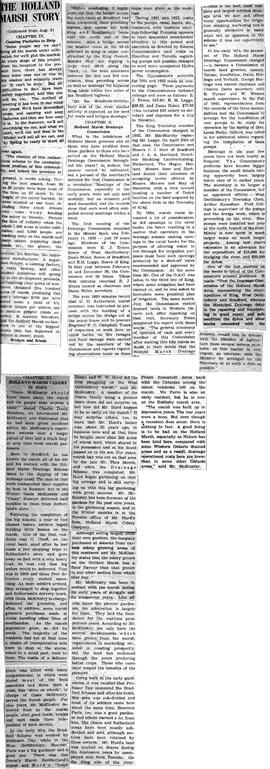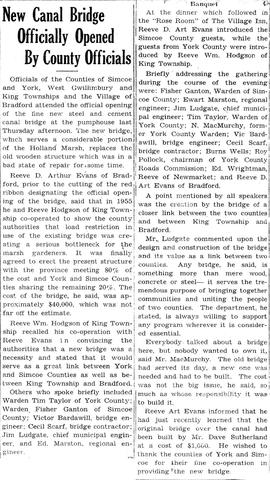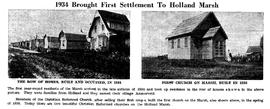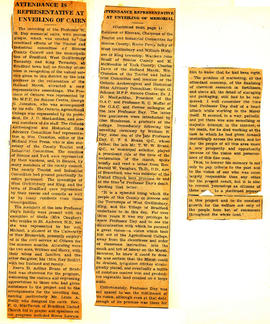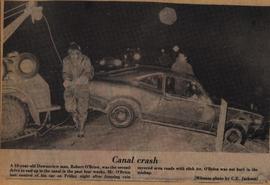The Holland Marsh Story Part Three
- CA BWGPL WEG-Mar-PH25490-PH25492
- Item
Part of WEGWHIST Collection
Description : The Holland Marsh Story
(Continued from Aug. 3)
CHAPTER IX
Canning Factories to Help
"Some people say we can't bring all the marsh under cultivation for we'll glut the market. At every stage of this project, from its inception to the present time, there has always been some wise one to rise to in his wisdom and solemnly warn us: "It can't be done." But all difficulties to date have been safely negotiated, and this one will be, too. The method of meeting it has been in our mind for years. We'll have diversified crops, and canning and soup factories, and then see how easy it is. In the Summer, we'll sell everything we can, and what we can't we'll can and then in the Winter we'll sell al we can, and by Spring be ready to start all over again.
"The relation of this reclamation scheme to the unemployment problem of this community, and indeed the province in general, is worth noting. During the past season, from 20 to 25 people were busy mos the time on 37 acres. In the height of the celery harvest, 43 were counted at one time, including three truck drivers hwo were busy hauling the celery to Toronto. Picture the hive of industry when the whole 7,500 acres is under cultivation, and 5,000 people are working daily on the marsh and many other supplying their needs, etc., the grocer, the clothier, the butcher, the implement manufacturer. A sugarbeet factory, and other kindred industries will spring up as the development proceeds, all requiring their quota of men. Seven thousand five hundred acres of marsh, producing this year's average $700 per acre would mean a yield of 5 1/4 million dollars per annum, not to mention greater yields expected. It appears, therefore, that the Holland Marsh reclamation is one of the biggest events that has happened in Ontario in recent years.
Bridges and Roads
"Before concluding, I might point out that the bridge across the main canal at Bradford has been completed, thus providing ingress and egress for both King and Gwillimbury lands near the north end of the scheme. Also a bridge across the smaller canal at the 15-16 sideroad in King is under construction by the King Council. Besides they are digging a large rood ditch along the "third", i.e., the road allowance between the 2nd and 3rd concession, thus providing access as well as drainage for adjacent King lands within two miles of the Bradford highway.
"on the Bradford-Gwillimbury side of the river, similar activity is expected, as the need for roads and bridges develops."
CHAPTER X
Holland Marsh Drainage Commission
What is the indebtness of Holland Marsh growers and all those who have profited from these gardens to those who have served on the Holland Marsh Drainage Commission throughout the years? In dollars, the answer cannot be estimated, but a perusal of the secretary's minutes for that Commission is a revelation. Meetings of the Commission, especially in the early years, were not only held monthly, but as occasion and need demanded, and the records show that such need often compelled several meetings within a week.
The first meeting of the Drainage Commission recorded in the Minute Book was February 14, 1930 -- juse 19 years ago. Members of the Commission were E.J. Evans, Reeve of West Gwillimbury; Denis Nolan, Reeve of Bradford and E.M. Legge, Reeve of King. In that year between February 14 and December 26, the Commission met 38 times. Those first minutes recorded by E.J. Evans named as chairman and Denis Nolan as secretary.
The year 1930 minutes record that D.H. Sutherland, marsh overseer, was instructed to proceed with the building of a bridge across the dredge cut at the pump house and to precure Engineer F.G. Campbell. Tours of inspection on work done on canal banks, on fire ravages and flood damage were carried out by the members of the Commission and reports regarding observations made on these tours were given at the meetings.
During 1931 and 1932, visits to the pumps, canal banks, etc., continued with business meetings following. Pumping appears to have demanded considerable attention in this period and materials as directed by Simcoe Commissioners paid visits to Hamilton and Toronto regarding pumps and possible changes to meet more economical Hydro power consumption.
The Commission's accounts for 1931 and 1932 made an interesting page. These payments to the Commissioners included mileage and were as follows: E.J. Evans $47.80; E.M. Legge, $39.50 and Denis Nolan, $75.00 (this included $20 salary as secretary and expenses for a trip to Toronto.)
The King Township member of the Commission changed in 1933; Mr. MacMurchy replacing Mr. Legge. On April 25th of that year the Commission met Messrs. J.J. Snor of Bradford and J.A.A. Hatrland, Directeur Stichting Landverhuizing, Netherland, The Hague, Holland. Messrs. Snor and Hartland stated their intention of accepting terms offered by Messrs. Manson and May of Hamilton, with a view toward locating a number of Dutch families on the land acquired by the above firm in the Township of King.
By 1934, marsh roads demanded a lot of consideration, as did openings in the canal banks, the latter resulting in a motion that operators in the drainage scheme making openings in the canal banks for the purpose of allowing water to run through for irrigation purposes must have such openings protected by a shut-off valve recommended and approved by the Commission. At the same time Mr. Cox of the O.A.C. was taken to the third line of King, where some irrigation has been carried on, and he was asked to formulate some practical plan of irrigation. The same month, July, the Commission visited drained lands in Western Ontario and, after reporting on that visit, Secretary Nolan completed his report with these words: "The general concensus of opinions of each and every member of this Commission after making this trip leaves no doubt in their minds that the Holland Marsh Drainage Scheme is the best, most complete and largest artificial drainage area we saw and offers many opportunities for irrigation, shipping, marketing and is generally attractive in many ways not so apparent in the scheme it was our opportunity to see."
In the early '40's, the personnel of The Holland Marsh Drainage Commission changed -- it became a Commission of marsh land growers, namely, Turner, Goodfellow, Davis, Horlings and Verkaik. George Horlings was named chairman and Charles Davis secretary, with B. Turner and W. Watson marsh supervisors. In the Fall of 1943, representatives from the councils of the three municipalities met the Commission to arrange for the installation of new pumps to be ready for operation by the Spring of 1944. Louis Neilly, Gilford, was called in for additional advice regarding the installation of these pumps.
Meetings in the past few years have not been nearly so frequent. The Commission's problems have become bigger business, the small details having apparently been largely taken car of in earlier years. The secretary is no longer a member of the Commission, but an appointed official -- West Gwillimbury's Township Clerk, Arthur Kneeshaw. Fred Collings is supervisor of the pumps and the dredge work, which is proceeding on the river. New pumps were installed last year at the north branch of the river. Money i snow spent in much larger sums on much larger projects. Among last year's estimates is an allowance for the expenditure of $15,000 for dredging the river, and $20,000 for dykes.
One of the last motions on the books is typical of the Commission's present problems. It reads: " That the Drainage Commission of the Holland Marsh Area, representing the municipalities of King, West Gwillimbury and Bradford, whereas the Municipal Drainage delay in the repairing and maintaining in good repair and safe condition the dykes and other works connected with the Scheme, would like to discuss with the Minister of Agriculture these several serious problems, as this matter is very urgent, an interview with the Minister be arranged by the Secretary at as early a date as possible."
CHAPTER XI
HOLLAND MARSH CELERY IS TOPS
"Oasie McKinstry should know more about the marsh and its people then anyone I know," stated Charlie David, therefore, we interviewed Mr. McKinstry and discovered that we had been given excellent advice. Mr. McKinstry's experience extends over a longer period of time and a much larger area than most marsh gardeners.
Born in Bradford, he has known the marsh all of his life and his contact with the Holland Marsh Drainage Scheme dates to the digging of the drainage canal. The men on that work transported their supplies by boat in Summer, but in the Winter, Oasie McKinstry and "Casey" Stewart delivered food supplies to them from Sutherland's Store.
Following the completion of the big scheme, a year or two elapsed before settlers began building little homes on the marsh. One of the first residents was C. Coert, on the canal bank, and after he had made a few shopping trips to Sutherland's store and gone away on foot with a very heavy load, he was told that big orders would be delivered. That was in 1930 and those first deliveries really started something. As more settlers arrived, they arranged to shop together and Sutherland's delivery truck, with Oasie McKinstry in charge, delivered the groceries, and often, in addition, some marsh grower's purchases made at stores handling other lines of merchandise. As the marsh population grew, so did its needs. The majority of the residents had not at that time a means of transportation into town to shop at the stores, which in a small part, went to them. The inside of a delivery truck was fitted with many compartments, in which were stored most of the food essentials and three days a week, this "store on wheels", in charge of Oasie McKinstry, served the marsh people. For nine years, Mr. McKinstry delivered good to the marsh people, until good roads, trucks and cars made them independent of such service.
In the early 30's, the Bradford Scheme was worked by Professor Day, while in the West Gwillimbury, Emerson Faris was a big gardener and a good one. There was also Doane's Marsh, Sutherland's marsh and Hurd's. "Ralph Doane and W.W. Hurd did the first ploughing on the West Gwillimbury marsh," said McKinstry. A member of the Doane family being a pioneer down there did not surprise us, but how did Mr. Hurd happen to be so early on the marsh? It may surprise other, too, to learn that Mr. Hurd's father was, about 50 years ago, in business here and at that time he bought more than 300 acres of marsh land, which stayed in his possession and at his death passed on to his son. For years, marsh hay was cut on that area by the late Mr. Thos. Morris, and when the Drainage Scheme was completed, Mr. Hurd began gardening on that big acreage and is still carrying on with this big gardening with great success. Mr. McKinstry has been foreman of his gardens for the past nine years, in the gardening season, and in the winter months is in the Toronto office of Mr. Hurd's firm, Holland Marsh Celery Company.
Although selling largely from their own gardens, the company purchased at seasons from various celery growing areas of this continent and Mr. McKinstry states that the celery grown on the Holland Marsh has a finer flavor than that grown in any other section from which they buy.
Mr. McKinstry has been in contact with the marsh during its early years of struggle and its prosperous years. Like all who knew the pioneer gardeners, his admiration is largely for them. They laid the foundation for the wartime prosperous years. According to Mr. McKinstry, not only have the several developments which have grown from the marsh, organization in marketing, etc., aided in creating prosperity, but the land has mellowed through the years producing better crops. Those who came later reaped the benefits of the pioneers.
Going back to the early gardeners, it was recalled that Professor Day pioneered the Bradford Scheme and after his death this area was sub-divided and most of its settlers came here about the same time. Emerson Faris, too, was a good gardener and others learned a lot from him. The Doane and Sutherland areas have been mostly sub-divided and sold, although sections have been retained by these owners. Mr. Hurd's land was worked on shares during the depression years by unemployed men from Toronto. On the Kind side of the river. Frank Romanelli dares back with the Catanias among the oldest residents left on the marsh. Vic Ferro is also an early resident, but he is now on the Kettleby marsh area.
"The marsh was built up in depression years. The war years were a boom. But even though a recession does occur, there is nothing to fear. A good living is to be had on the Holland Marsh, especially as Nature has been kind here, compared with some Western Ontario drained areas and as a result, drainage operational costs here are lower than in some other Ontario areas," said Mr. McKinstry.
Bradford Witness

